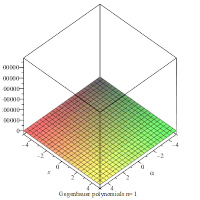Gegenbauer polynomials
In mathematics, Gegenbauer polynomials or ultraspherical polynomials C(α)
n(x) are orthogonal polynomials on the interval [−1,1] with respect to the weight function (1 − x2)α–1/2. They generalize Legendre polynomials and Chebyshev polynomials, and are special cases of Jacobi polynomials. They are named after Leopold Gegenbauer.
Characterizations[]

Gegenbauer polynomials with α=1

Gegenbauer polynomials with α=2

Gegenbauer polynomials with α=3

An animation showing the polynomials on the xα-plane for the first 4 values of n.
A variety of characterizations of the Gegenbauer polynomials are available.
- The polynomials can be defined in terms of their generating function (Stein & Weiss 1971, §IV.2):
- The polynomials satisfy the recurrence relation (Suetin 2001):
- Gegenbauer polynomials are particular solutions of the Gegenbauer differential equation (Suetin 2001):
- When α = 1/2, the equation reduces to the Legendre equation, and the Gegenbauer polynomials reduce to the Legendre polynomials.
- When α = 1, the equation reduces to the Chebyshev differential equation, and the Gegenbauer polynomials reduce to the Chebyshev polynomials of the second kind.[1]
- They are given as Gaussian hypergeometric series in certain cases where the series is in fact finite:
- (Abramowitz & Stegun p. 561). Here (2α)n is the rising factorial. Explicitly,
- They are special cases of the Jacobi polynomials (Suetin 2001):
- in which represents the rising factorial of .
- One therefore also has the Rodrigues formula
Orthogonality and normalization[]
For a fixed α, the polynomials are orthogonal on [−1, 1] with respect to the weighting function (Abramowitz & Stegun p. 774)
To wit, for n ≠ m,
They are normalized by
Applications[]
The Gegenbauer polynomials appear naturally as extensions of Legendre polynomials in the context of potential theory and harmonic analysis. The Newtonian potential in Rn has the expansion, valid with α = (n − 2)/2,
When n = 3, this gives the Legendre polynomial expansion of the gravitational potential. Similar expressions are available for the expansion of the Poisson kernel in a ball (Stein & Weiss 1971).
It follows that the quantities are spherical harmonics, when regarded as a function of x only. They are, in fact, exactly the zonal spherical harmonics, up to a normalizing constant.
Gegenbauer polynomials also appear in the theory of Positive-definite functions.
The Askey–Gasper inequality reads
See also[]
- Rogers polynomials, the q-analogue of Gegenbauer polynomials
- Chebyshev polynomials
- Romanovski polynomials
References[]
- Abramowitz, Milton; Stegun, Irene Ann, eds. (1983) [June 1964]. "Chapter 22". Handbook of Mathematical Functions with Formulas, Graphs, and Mathematical Tables. Applied Mathematics Series. 55 (Ninth reprint with additional corrections of tenth original printing with corrections (December 1972); first ed.). Washington D.C.; New York: United States Department of Commerce, National Bureau of Standards; Dover Publications. p. 773. ISBN 978-0-486-61272-0. LCCN 64-60036. MR 0167642. LCCN 65-12253.*Koornwinder, Tom H.; Wong, Roderick S. C.; Koekoek, Roelof; Swarttouw, René F. (2010), "Orthogonal Polynomials", in Olver, Frank W. J.; Lozier, Daniel M.; Boisvert, Ronald F.; Clark, Charles W. (eds.), NIST Handbook of Mathematical Functions, Cambridge University Press, ISBN 978-0-521-19225-5, MR 2723248
- Stein, Elias; Weiss, Guido (1971), Introduction to Fourier Analysis on Euclidean Spaces, Princeton, N.J.: Princeton University Press, ISBN 978-0-691-08078-9.
- Suetin, P.K. (2001) [1994], "Ultraspherical polynomials", Encyclopedia of Mathematics, EMS Press.
- Specific
- ^ Arfken, Weber, and Harris (2013) "Mathematical Methods for Physicists", 7th edition; ch. 18.4
- Orthogonal polynomials
- Special hypergeometric functions





![{\begin{aligned}C_{0}^{\alpha }(x)&=1\\C_{1}^{\alpha }(x)&=2\alpha x\\C_{n}^{\alpha }(x)&={\frac {1}{n}}[2x(n+\alpha -1)C_{{n-1}}^{\alpha }(x)-(n+2\alpha -2)C_{{n-2}}^{\alpha }(x)].\end{aligned}}](https://wikimedia.org/api/rest_v1/media/math/render/svg/d7f7e040cb401c72d41eab0bda662f115229feed)






![{\displaystyle C_{n}^{(\alpha )}(x)={\frac {(-1)^{n}}{2^{n}n!}}{\frac {\Gamma (\alpha +{\frac {1}{2}})\Gamma (n+2\alpha )}{\Gamma (2\alpha )\Gamma (\alpha +n+{\frac {1}{2}})}}(1-x^{2})^{-\alpha +1/2}{\frac {d^{n}}{dx^{n}}}\left[(1-x^{2})^{n+\alpha -1/2}\right].}](https://wikimedia.org/api/rest_v1/media/math/render/svg/7380d774285ba35cc371daa8be46e38b2442eca1)


![\int _{{-1}}^{1}\left[C_{n}^{{(\alpha )}}(x)\right]^{2}(1-x^{2})^{{\alpha -{\frac {1}{2}}}}\,dx={\frac {\pi 2^{{1-2\alpha }}\Gamma (n+2\alpha )}{n!(n+\alpha )[\Gamma (\alpha )]^{2}}}.](https://wikimedia.org/api/rest_v1/media/math/render/svg/a9b5696990f291fed55949f3b9e2f1669b9f4c83)


